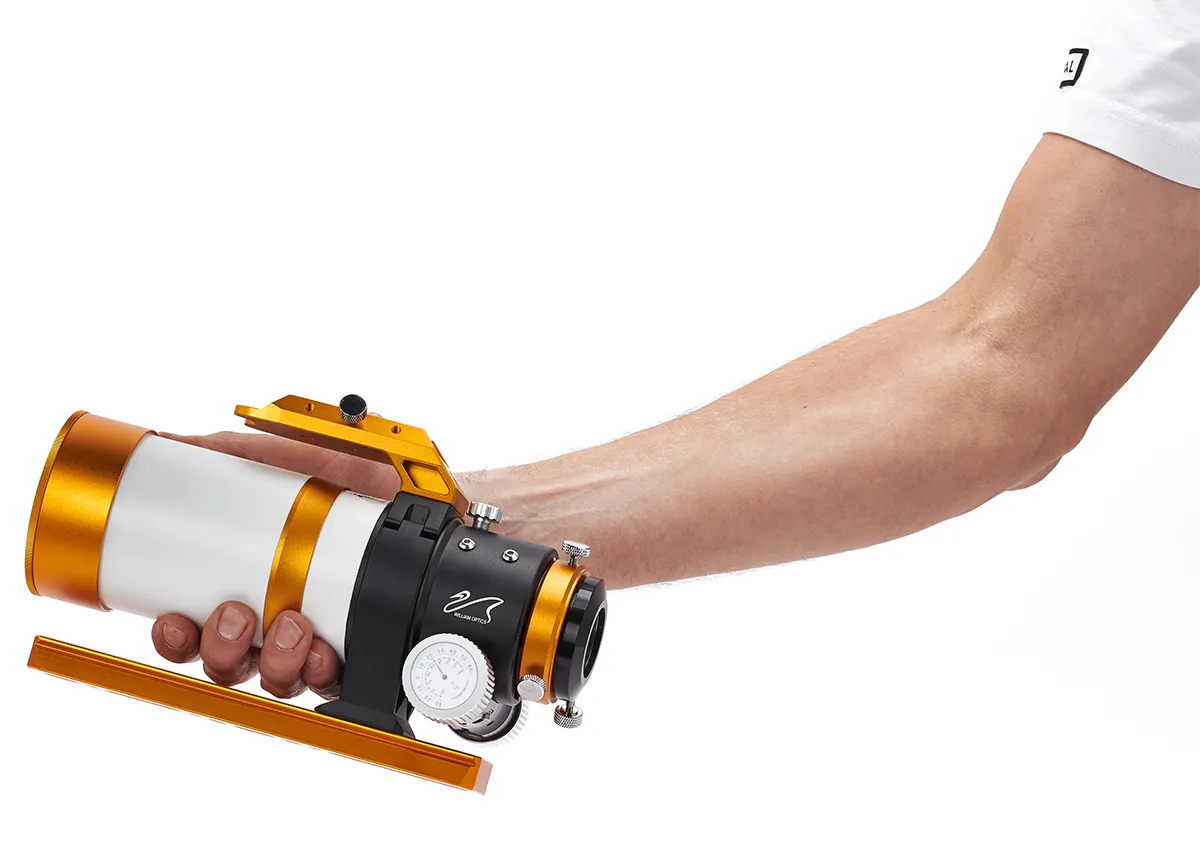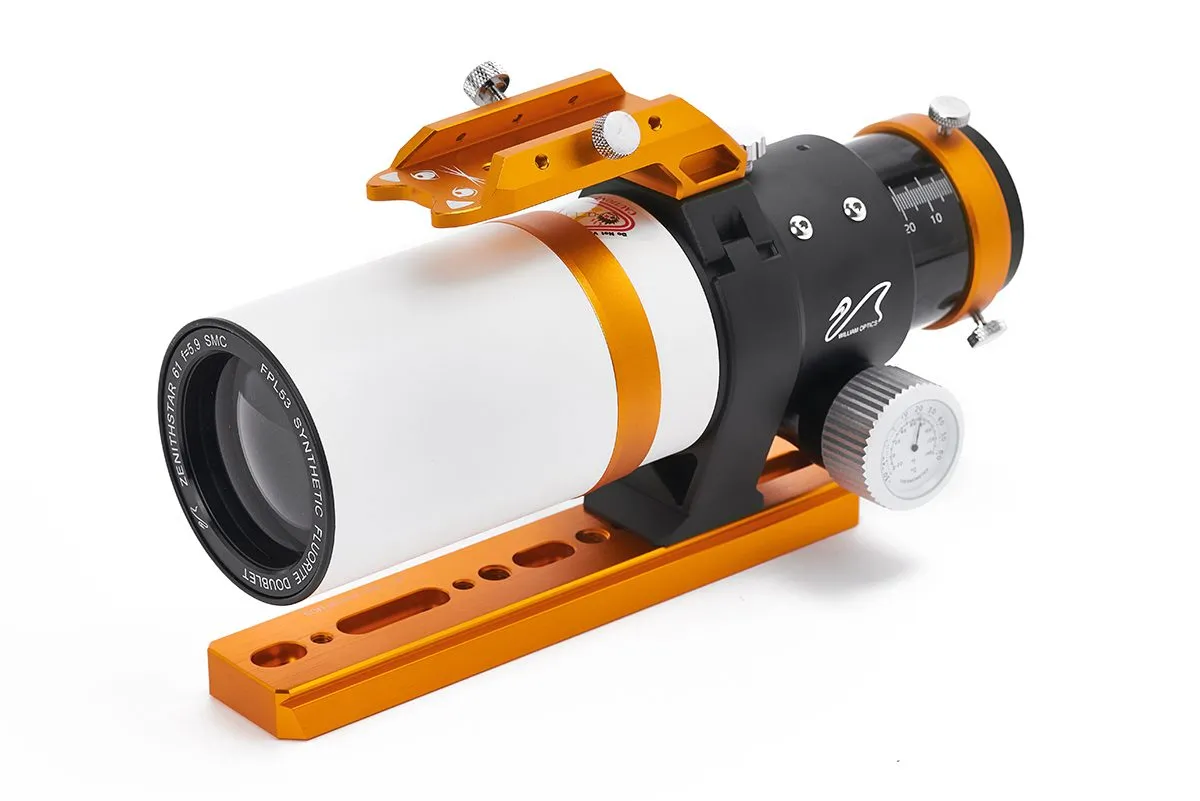We could sum up the William Optics Zenithstar 61 II APO refractor as tiny and serious or seriously tiny. It’s a small, portable instrument with a 61mm air-spaced, colour-corrected doublet lens, which definitely packs a punch, especially when used for astrophotography.
The main tube is white with a black clamping ring and focuser barrel, while a choice of colours – grey, gold or red – is used on the dust cap, dew shield, eyepiece clamp and mounting bar.
If you decide to add on the optional UniGuide guidescope, this can be purchased with a matching colour as well.
The ZS61-II’s 61mm objective lens has a focal length of 360mm, giving it a mid-range focal ratio of f/5.9.
Being so small and portable, this wide-field scope is ideal for capturing views of the star fields and nebulae that are visible from dark-sky locations.

The scope can also be used for taking photos of the Moon and planets and – with safety precautions adhered to and a suitable filter – the Sun. Just don’t expect detailed close-ups with such a short focal length.
It would be ideal for eclipse chasing, however, as its naturally wide-field coverage is ideal for the expansive nature of the Solar corona during totality.
During visual testing we found stars appeared sharp and bright in the middle of the field, while clusters came vibrantly to life.
The wide, generous field of view was great for putting regions such as the Double Cluster and Orion’s Sword in context.
Looking at a bright Moon, we were pleased about the absence of unwanted colour fringing, the air-spaced FPL-53 doublet lens doing a great job.
While imaging, we found that the Bahtinov mask provided in the removable dew shield made it a breeze to reach accurate focus. This was also due partly to the ZS61-II’s dual-speed rack and pinion focuser, which we liked as it felt very positive and responsive.

The ZS61-II’s focused image circle will illuminate a full-frame DSLR sensor. Using a Canon EOS 6D DSLR camera we noticed a small amount of vignetting – when the brightness of an image falls away towards the extreme corners of the frame – but nothing that couldn’t be corrected with the application of flat frames.
We also noted that optical distortion was present towards the edge of frame. It was by no means terrible, but it would get in the way of serious astrophotography.
This can be addressed using an optional field-flattener, such as the William Optics Flat 61A which is designed for use with this scope – although this will set you back an extra £170. At the time of the review the flattener wasn’t available.
As a reworked model of the ZS61, the ZS61-II also offers many thoughtful touches, including the Bahtinov focus-assist mask mentioned earlier, an extendable dew shield and the dual-speed rack and pinion focuser.What’s new is the mounting cradle, which has a mounting point for an optional guidescope.

We tested the William Optics UniGuide guidescope with a 50mm aperture and a 200mm focal length, an optical specification that’s not far from the ZS61-II itself. Of course, the UniGuide’s optics aren’t as refined, nor are its focuser or eyepiece holder.
The UniGuide costs a further £125, but it’s worth it if you’re serious about auto-guided long-exposure imaging.
It’s designed to accept a modern, small format guide camera, such as those produced by QHY, ZWO and Altair, with the camera fitting into a 1.25-inch Rotolock adaptor – a 1.25-inch focuser that uses an external rotary screw collar for locking the camera in place.
Focusing is achieved by adjusting the front section of the UniGuide and locking it with a ring. The UniGuide is fast at f/4 and delivers a big, wide field of view. Typically, this means you should have a good number of guide stars to choose from.
In summary, the ZS61-II is an attractive scope for wide-field viewing and astrophotography. It’s highly portable and feels as if it would survive a bump or two, plus it’s easy to use and doesn’t compromise on functionality.
It would also make a high-quality guidescope for a larger instrument.
Zenithstar 61 II APO's portability
The William Optics ZS61-II is a quality instrument – perfect for wide-field, low power viewing – and it’s remarkably portable.
With the focuser and dew shield fully retracted, the scope is 25cm in length, 14cm high (from the bottom of the mounting plate to top of the ‘Cat Series’ saddle handle bar) and 8.5cm wide.
It’s supplied with a padded carry-case, which is large enough to accommodate optional extras, such as the recommended field-flattener, but not the UniGuide guidescope.
The main ZS61-II telescope – with mounting ring, ‘Cat Series’ saddle handle bar and mounting plate – weighs 2.15kg, which makes it easy to carry on visits to dark-sky locations. Just add a camera and you have a quality, easy-access imaging setup.
The UniGuide guidescope complements the ZS61-II; it’s easy to set up and is portable. It’s 25cm in length, 7cm in height and 5.5cm wide, and can be integrated into your usual guiding setup for extended long-exposure imaging.

Key features
UniGuide guidescope
Our review kit included a 50mm, f/4, 200mm focal length UniGuide guidescope with a 5.7˚ field of view. It is designed for a 1.25-inch guide camera barrel secured using a ‘Rotolock’ adaptor. Focusing is achieved by screwing and unscrewing the front objective lens and locking with a ring.
Mounting ring and saddle handle bar
The ZS61-II’s mounting ring has a ‘Cat Series’ saddle handle bar attached to the top of it. This provides a Vixen-style mounting saddle for attaching auxiliary equipment like the UniGuide guidescope shown here. Two locking thumbscrews secure equipment in the saddle.
Focuser
The ZS61-II has a tension-adjustable, dual-speed rack and pinion focuser, providing smooth movement through its 75mm drawtube range. The focuser accepts 1.25- and 2-inch barrels, securing them with compression rings. A micro-focus knob provides 1/10th speed adjustment for fine-focusing. The drawtube is ruled for repeat focus positioning, while the thermometer is useful to monitor temperature for variations that may affect focus.
Optics
The ZS61-II’s objective lens is an air-spaced doublet made from FPL-53 glass, fully multi-coated with Super-Multi Coating. It gives excellent colour correction when tested. The objective’s focal length is 360mm, making this an f/5.9 instrument. Field stop baffles are used to eliminate stray light.
Bahtinov mask
The Bahtinov mask inside the dust cap is a nice touch. Concealed behind a screw-off front plate, it’s extremely useful for achieving accurate focus by aligning the diffraction pattern it forms on a star to a common cross-over (see below).
Vital stats
- Price ZS61-II: £499.99; 50mm UniGuide guidescope: £125
- Optics Two-element, air-spaced apochromat (FPL-53 glass)
- Aperture 61mm
- Focal length 360mm (f/5.9)
- Focuser Dual-speed, rack and pinion, 2-inch barrel with 1.25-inch adaptor
- Extras Soft carry-case
- Weight ZS61-II tube only: 1.5kg; UniGuide guidescope: 0.5kg; fully assembled: 2.66kg
- Supplier Rother Valley Optics Ltd
- Tel 0190 977 4521
- www.rothervalleyoptics.co.uk
This review originally appeared in the January 2021 issue of BBC Sky at Night Magazine.
